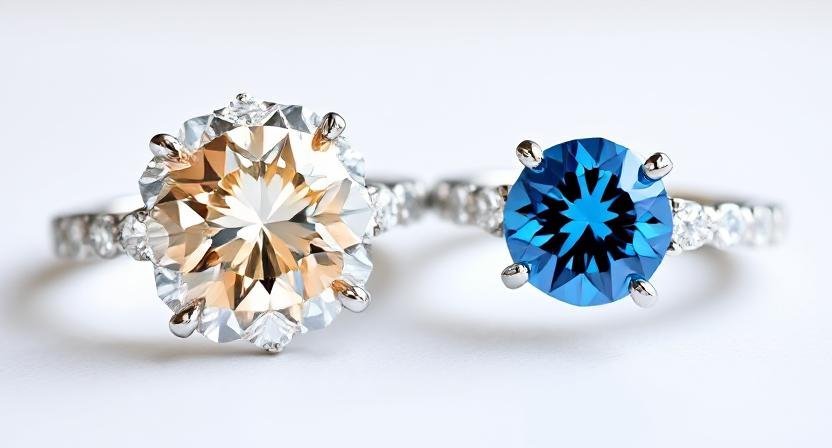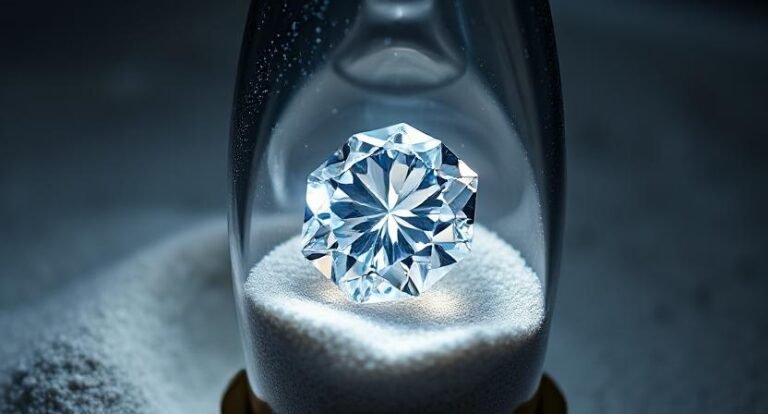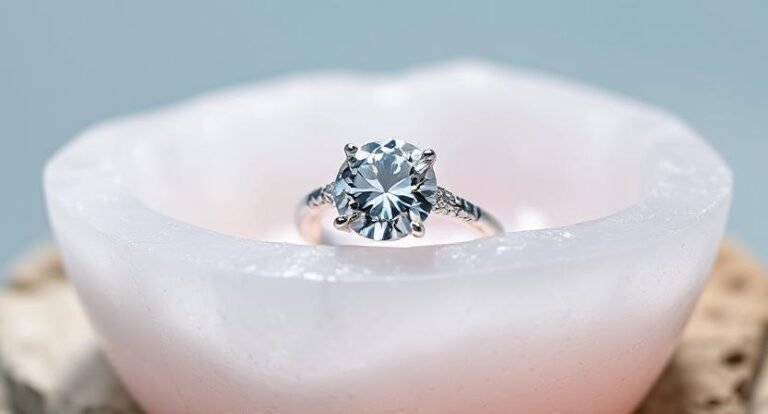The Allure of Colored Moissanite
Why Moissanite Isn’t Just “Diamond-Like”
Moissanite has broken out of the “diamond dupe” box. While its clarity and brilliance often mimic diamonds, its ability to display intense fire and its unique coloring options give it a charisma all its own.
The Rise in Demand for Colored Gem Alternatives
As modern consumers seek gemstones that blend individuality with sustainability, colored moissanite has stepped into the spotlight. From oceanic blues to sun-drenched ambers, the palette is expanding fast (and beautifully).
The Science of Moissanite’s Base Structure
Silicon Carbide and Its Optical Potential
At its core, moissanite is silicon carbide (SiC) – a rare compound in nature, but perfected in labs. This crystalline formation is incredibly stable and boasts a refractive index of 2.65–2.69, which gives moissanite its fiery brilliance.
Natural vs Lab-Created: A Quick Recap
Natural moissanite is scarce, originally discovered in meteorites. All jewelry-grade moissanite today is grown in labs, making it a technically precise and environmentally conscious alternative.
Understanding Moissanite’s Natural Coloration
The Base Color: Naturally Colorless or Faintly Tinted
Most lab-grown moissanite is colorless or near-colorless (graded D-E-F or G-H-I). On its own, it leans toward icy whites with occasional soft undertones depending on lighting.
What Causes Moissanite to Reflect Fire and Color
Moissanite’s internal dispersion is off the charts. It breaks light into flashes of rainbow hues (more so than diamonds) making even clear moissanite appear vibrantly “alive.”
The Role of Trace Elements and Impurities
Chemical Doping in Crystal Growth
During the crystal growth phase, scientists can introduce trace elements like iron, nickel, or titanium. These elements subtly alter the stone’s optical absorption, allowing for the formation of tinted or fully colored stones.
Heat and Pressure’s Influence on Hue
The growth environment matters. High-temperature, high-pressure conditions affect how impurities settle within the crystal lattice. A slight variation in these conditions can mean the difference between warm gold and subtle champagne.
Color Enhancement Techniques
Coating Technology: Thin-Film Layers Explained
One of the most common methods for creating colored moissanite is through thin-film coating. A nano-layer of color material, often just a few microns thick, is applied to the underside or pavilion of the stone. These layers are engineered for durability and brilliance.
Irradiation and Diffusion Methods
In more advanced cases, irradiation (using high-energy particles) and diffusion (heating the crystal with color-inducing chemicals) are employed to change the color within the actual structure of the stone, not just the surface.
Popular Colored Moissanite Shades and How They’re Achieved
Champagne and Cognac: Warm Tones with Earthy Charm
To get these golden-to-brown tones, coating or diffusion with iron or other transition metals is common. The result? A warm, rich sparkle that feels grounded yet luxurious.
Blue and Teal: The Depths of Oceanic Beauty
Blue moissanite is typically achieved using cobalt-based or proprietary coatings. These shades are highly sought-after for their calming, aquatic aesthetic.
Green and Yellow: Springtime in a Stone
Nickel and chromium-based alterations can create stunning green and yellow moissanite. These colors often feel vibrant and fresh, perfect for nature-loving souls.
Pink and Purple: Romance in Crystal Form
Manganese-infused coatings and other proprietary processes bring out luscious pinks and regal purples. These shades are typically surface-treated, but modern technology makes them impressively long-lasting.
How Stable Are the Colors?
Resistance to Fading Over Time
High-quality colored moissanite is surprisingly durable. Most colors resist fading under daily wear, though prolonged exposure to intense heat or UV light can eventually impact some surface treatments.
Heat Sensitivity and Cleaning Tips
While moissanite is safe for ultrasonic and steam cleaning, gentler methods are recommended for coated stones. Use mild soap, water, and a soft brush to preserve the vibrancy.
Are Colored Moissanite Gems Permanent?
Long-Term Durability of Surface vs Infused Color
Color created through diffusion or chemical doping is permanent and part of the crystal’s identity. In contrast, coated stones rely on that thin film for color, which, though durable, can wear or scratch under extreme conditions.
Manufacturer Warranties and What to Look For
Look for brands that back their colored moissanite with a minimum 1-year warranty. Reputable suppliers often provide detailed care instructions to ensure longevity.
Custom Orders: Can You Choose Your Own Hue?
Made-to-Order Options
Yes, many moissanite suppliers offer custom color orders. Choose the hue, cut, and carat (and some even offer “moodboard matching”) for engagement rings or special pieces.
Custom Lab Work and Limitations
Custom crystal coloration requires longer timelines and may cost more. Not every color is feasible through internal infusion, so expect certain hues (like vivid reds or rich blacks) to be surface-treated only.
The Future of Colored Moissanite
Ethical Gem Innovation
The moissanite industry is becoming a pioneer in clean tech and ethical luxury. Future advances may eliminate the need for surface coatings entirely, creating fully colored crystals from the inside out.
Expanding the Color Spectrum through Research
Lab teams are experimenting with exotic metal infusions and AI-assisted crystal growth, which could eventually result in new, undiscovered hues of moissanite – possibly even color-shifting stones.




